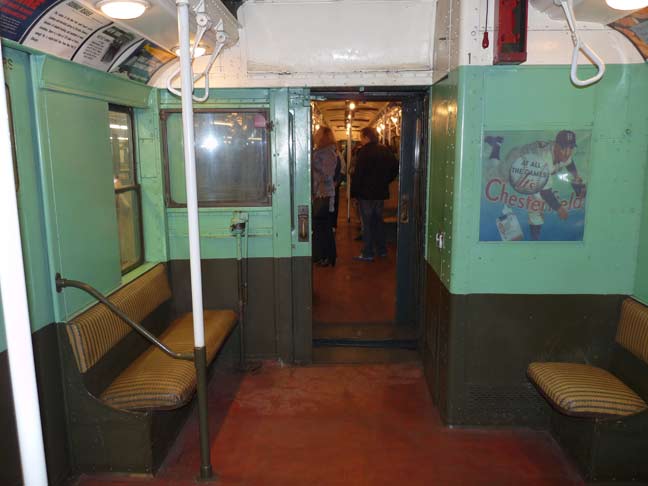Photos from the MTA Holiday Train, pretty much a trainset of cars from the 1930s-1950s trotted out in December and a few times a year for pleasure excursions, will leach out in FNY this month.
All I’ll say about this photo is that subway cars have gone from looking like organic, living and breathing embodiments of the industrial revolution into the anodyne chrome capsules of today, with programmed voices and shiny shiny chrome, because chrome shouts modern efficiency. But you should have been on this thing as it roared under the East River.
12/3/12


12 comments
THE NOISES THEY MADE. THECOMRESSERS GOING ON AND OFF, THE PUFF OF AIR AS THE DOORS CLOSED. THE WHINE AS IT ACCELERATED. AND THE SMELL OF BURNING OIL …ALONG WITH A LITTLE URINE
Nostalgia Train is composed IND R1-9 series cars, built between 1932 and 1941. The last ones ran in revenue service in 1976. These cars introduced to New York a physical car dimension still used today on all of the lettered (IND-BMT) subway lines – 60 foot carbody with four doors per side. This design maximizes the door openings (40 doors per ten car train) allowing rapid entering and exiting at station stops. After a brief flirtation with 75 foot cars on the IND-BMT routes, the newer R143 and R160 cars have returned to this basic 60 body style.
Anodyne. That’s a word you don’t hear every day.
Many of Kevin’s blogs contain words you don’t hear every day – an extra – a way to enhance one’s vocabulary if you will. Kerfuffle was used in a recent post (can’t remember which one) and I frequently find myself googling these rarely used words (I probably learned them in 10th grade English – Mr. Boyce made sure we learned words like that).
I just know ’em.
I always tried to get that seat right behind the motorman’s (or conductor’s) compartment. In the picture it looks like two people (if they are/were small and skinny) could sit there, but in most cases if I sat there, there was only about a 1/2 seat remaining, so most people didn’t try to squeeze in. This gave me room to kind of stretch out a bit.
There’s always one person determined to NOT let you have that seat for yourself. No matter how big you are, or how big they are, they will squeeze in next to you. I guess they do it to get their dollars (or what is it now $2.50?) worth.
Can’t forget the “corn on the cob” seats, rivaled only by the exposed ceiling fan blades that could have easily scalped a tall standing passenger (now nauseatingly referred to as “customers”).
It was not only the old cars that were noisy, but the wheels on the tracks were, too. Back in the day, there were no welded rails or rubber cushions between the tracks and the ties. Every wheel crossed over every rail end with a “clickety-clack” and the car absorbed each crossing with a small shudder. It often required shouting to continue a conversation with the person next to you, and that was if the train was on an elevated line. It was almost impossible to have a conversation when you were roaring through a tunnel at high speed and the noise echoed all around you. If you wanted to listen to music in those days you needed a boom-box to hear it over the noise of the train!
Come on standing by that front door with that half window open on a BMT standard best 15 cents
you could ever spend !
The corn on the cob seats were great, except when heat was coming out in July.
OK, Kevin, here it is, finally, a subway car photo with that object I’d described long ago to you, the same question still unanswered. Can you name the water pump-like object on the left side of the car? Is it a handbrake, an air brake, or a long-handled door opener installed incase of emergency? This object has dogged me for well over 45 years! Opposite is the red pull cord for the emergency hand brake, so the pump thingee would be redundant. It looks like something out of Petticoat Junction or Moodus CTc. 1967. I rode the NYC subways from 1958 to 1988, mainly the IND (Queens Blvd. or Sixth Avenue) and IRT #7 Flushing lines, nearly every day. Therefore I so remember these cars well before their walls were repainted (that ugly green or khaki/beige). I thought I was the only one calling the upholstery ‘corn cob.’ I can still smell the hot foul air, hear the not-quite-locked doors slamming back and forth, and hoping I made the ‘jump’ between cars in one piece. It paid to be a little kid with long legs.